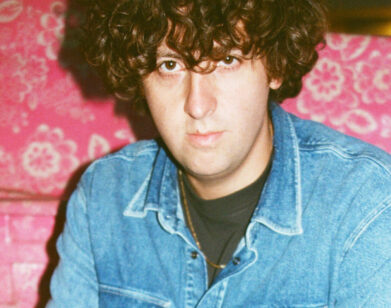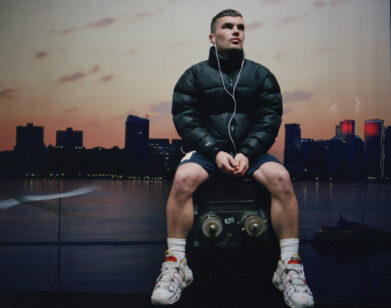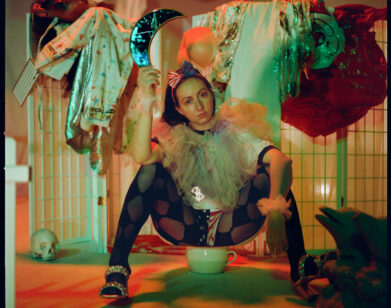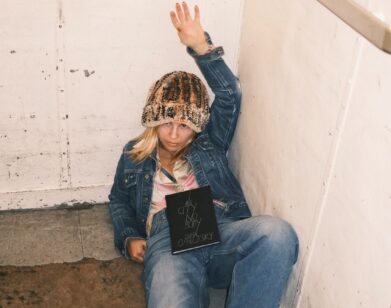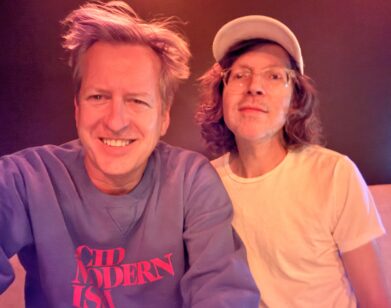Leyla Aliyeva
WE ARE STILL QUITE A YOUNG COUNTRY . . . YET WE HAVE A VERY ANCIENT HISTORY. NOT MANY PEOPLE KNOW THAT IN AZERBAIJAN, WOMEN WERE GIVEN THE RIGHT TO VOTE IN 1918. THAT WAS BEFORE ENGLAND.Leyla Aliyeva
Azerbaijan: land of avant-garde artists, fashion extremes, environmental activism, and next-wave global architecture. This might not be the typical impression conjured in the West at the mention of the former Soviet republic that straddles Eastern Europe and Asia. But if Leyla Aliyeva, the 26-year-old editor, artist, activist, and eldest daughter of current president Ilham Aliyev, has her way, her country—and, in particular, its capital of Baku—will soon rival New York, Berlin, and Tokyo as a cultural epicenter of the world.
In fact, Aliyeva has so many projects in the works—films, charities, animal-rights ventures, youth campaigns, a Zaha Hadid–designed cultural center currently under construction and scheduled to open in May—it’s hard to comprehend how this mother of two has managed to turn 2012 into the year of Azerbaijan. First there is the international launch of her magazine, Baku, which Aliyeva began publishing in 2007 from Moscow, where she aimed to raise awareness about the cultural goings-on of the Azerbaijani capital as well as create a platform for special curated projects in art and fashion. As editor-in-chief, Aliyeva teamed up with CondeÌ Nast last October to publish an international English-language version, and next month, she is hosting a launch party in New York to celebrate the arrival of the April issue on U.S. newsstands. Then there is the contemporary art exhibition “Fly to Baku” that Aliyeva helped organize, a stunningly eclectic show of 21 Azerbaijani sculptors, painters, video artists, and photographers, whose home bases range from the Caspian Sea all the way to Brooklyn. The exhibition lifted off in January at Phillips de Pury in London with plans to have it travel around the globe. It was hardly a surprise to find amid the work the drawings of Aliyeva herself, who somehow finds the time to pursue her own creative interests along with those of her country.
Can Azerbaijan truly be the next cultural hub? Certainly, Aliyeva is in strong company with other glamorous, ambitious young women who, in recent years, have managed to bring some of the art-world spotlight toward their projects in the East. Of course, it isn’t all Aliyeva’s doing: Last year an Azerbaijani singing duo, Ell/Nikki, won the Eurovision Song Contest with its song “Running Scared.” Not bad for a country that only entered the competition four years ago. This May, Baku will host the Eurovision Song Contest, calling attention to the city and, with it, the artistic vibrancy Aliyeva has made it her mission to promote. Aliyeva recently sat down with Simon de Pury in London before the opening of “Fly to Baku” to discuss the future (and vital present) of the land she loves.
SIMON DE PURY: What a pleasure to see you on the occasion of the opening of your exhibition. I remember that my wife Michaela and I went to your birthday party last summer in Baku. We had never been there before, and we were only there for 36 hours, during which time we visited a lot of artists’ studios. We were excited about it because there is so little known about Azerbaijani contemporary art. That’s why staging this show was such a great decision. And the curator, HerveÌ Mikaeloff, is such a visionary.
LEYLA ALIYEVA: Yes, it’s 21 artists and more than 100 works. Some of the artists are emerging and new, and some are already famous. But what’s interesting is that most of the work has been specially prepared for this exhibition, so it’s being shown for the first time.
DE PURY: And you intend to have it travel after London, correct?
ALIYEVA: Yes, we are planning to take it to Paris, Berlin, Rome, Moscow, and hopefully New York. Then we are planning to end the show in Baku, to bring it back home, probably at Baku’s Museum of Modern Art, which was built in 2009.
DE PURY: What would you say is the common thread between all of these different artists—besides the fact that they all come from Azerbaijan?
ALIYEVA: Each one is very individual, very different. But because they all come from Azerbaijan, their work is still related to the capital city of Baku. There is a long tradition of art in Azerbaijan, so these artists are commuting within a larger cultural heritage. If you’ve ever been to Gobustan, we have cave drawings that date back thousands of years. So while Azerbaijan might not be thought of as an art capital, it has a very rich past from ancient to modern times. Azerbaijan is a place of mixed cultures, religions, and traditions, and that is reflected in the art. Even in the mixture of East and West, which is evident in the work.
DE PURY: Do you have any personal favorites from the exhibition?
ALIYEVA: [laughs] Well, I like all of them, but when I really fall in love with a work it happens right away, and it really has only happened to me twice. Once it happened in the Museum of Modern Art in Baku when I saw the work of Niyaz Najafov. It was even before the museum opened, and I remember standing there stunned by his work. The second time was not with an Azerbaijani artist. In fact, it happened in your gallery, and it was when I saw the work of George Condo.
DE PURY: Would you be interested in showing his work in Baku?
ALIYEVA: I would love to, yes. These are my two favorite living artists at the moment.
DE PURY: Since this will be read by an international audience, do you think there is anything that they don’t know about Azerbaijan that you want to tell them? We’re having this conversation here in London, and I must say that, for me, before I had the pleasure of meeting you, Azerbaijan sounded very exotic, but I didn’t even know exactly where it was. To my amazement, it’s just a few hours by plane from London.
ALIYEVA: Geographically, we’re on the Caspian Sea, and we’re just on the border between East and West—Asia and Europe— which makes it very interesting. But we are still quite a young country. We’ve only celebrated 20 years of the restoration of our independence last year. Yet we have a very ancient history. Not many people know that in Azerbaijan, women were given the right to vote in 1918. That was before England.
DE PURY: And Switzerland—long, long, long before Switzerland. [laughs]
ALIYEVA: Yeah, and also the first secular school for girls was built in 1901. We also had the first Western opera in the East. And I think Azerbaijan, because of being located in the West and East, is really known for its open-mindedness and tolerance. It’s a place where you can see mosques, synagogues, and churches all together. For us there has never been a problem. It’s a tolerance that we acquire at birth. And I think that is reflected in the art exhibited here today.
DE PURY: When I came to Baku, one of my surprises was to see that you are yourself an artist. I want to make clear that we were never asked to include any of your work in the exhibition. But HerveÌ Mikaeloff told me that when he saw your work, he decided he had to have it as part of the exhibition.
ALIYEVA: I have drawn ever since I can remember. I studied art in school and took private lessons, but I never really had an art education in the traditional sense. Drawing is an education because the more you draw, the more you understand how to do it and how to make it better. Usually, once I start drawing, I can’t stop, and sometimes I can’t sleep the night before I finish a drawing because I’m consumed with the thought of it. I made four works specifically for this exhibition. I can’t compare myself to the others in the show, but I tried my best.
DE PURY: I noticed one of your pieces in this show that I very much admired. It was a still life of a big fruit that is very common in Azerbaijan.
ALIYEVA: It’s a pomegranate. Because the show is called “Fly to Baku,” I wanted to do something that associates with Baku, and the pomegranate is a very famous fruit in Baku. You can’t taste this kind of pomegranate anywhere else. That’s why I decided to paint that.
DE PURY: Being an artist yourself certainly helps you to appreciate the work of others.
ALIYEVA: I think so. I know how important it is for the artist. And it’s difficult to sell a work when you know that, because you understand all of the effort involved. It’s also really difficult to sell it, when you draw yourself. It’s something that you don’t want to part with because you know how much effort you put into it.
DE PURY: Many people in the museum world and the art market started as artists—myself included. A lot of them don’t admit to it, but they were. I think when you are an artist yourself, it teaches you about looking.
ALIYEVA: I can spend hours at the art galleries and museums. The Tate museum, the National Gallery— I can look at a single painting for hours.
DE PURY: What is this I hear about you also being a poet?
ALIYEVA: Yes, but not a poet. I just write poetry, ever since my childhood, for myself. But you haven’t read my poems, have you?
DE PURY: No, I must admit I haven’t.
ALIYEVA: I write only in Russian. Sometimes I have them translated. I will let you read one sometime.
DE PURY: I also hear you are very much into music.
ALIYEVA: Yes. I like to promote music—not play it. I’m afraid I don’t have any talent in that department. But music is very important in Azerbaijan. We have mugam, which is folk music, but it’s also a sort of philosophy. It comes from Karabakh. And on the other side, you probably know that we won the Eurovision Song Contest. That’s a big victory for us. Now we get to host the next one in May. I’m looking forward to that. And we are ready for it because this year Baku has a number of five-star hotels opening, including the Four Seasons. It’s the first Four Seasons in a post-Soviet country. And Zaha Hadid’s cultural center is under construction right now. It’s an architectural masterpiece. So it’s really an exciting time for us.
DE PURY: These different forms of art—visual art, music, literature, even fashion—all come together in your own magazine, Baku. All of the artificial borders between different disciplines are coming down, and your magazine reflects that spirit.
ALIYEVA: We started the magazine four years ago in Moscow. Starting that magazine was my dream, and it turned into a great success. It talks a lot about culture, music, art, history, and a lot about people—not just famous people in Azerbaijan, but also ordinary people who have an interesting story to tell. It became a rather dear publication to a lot of people and I knew I wanted to do an English version. We decided to do a version with CondeÌ Nast because they understood the idea right away. Although the magazine is called Baku, it isn’t only about Baku. To be honest with you, each issue is like an art piece. And we dedicate each issue to a different scene and different artists. Last issue, we invited Mr. Brainwash to do a special piece for the magazine. For another issue, we invited Rich Simmons to Baku. He’s an upcoming street artist, so he did some interesting work on the streets of Azerbaijan.
DE PURY: It’s a fascinating take on contemporary culture. It doesn’t look like a tourist brochure for Azerbaijan, that’s for sure.
ALIYEVA: I do want it to be interesting for people who have never even been to Baku and don’t know much about it. And then it’s also something others will pick up because it looks beautiful and interesting.
DE PURY: It definitely raises the desire to go to Baku. How do you do it all? You have so many interests and projects going on. It’s one thing having great ideas, but the key is to see that those ideas then get realized. Are you a workaholic?
ALIYEVA: Well, I travel almost every week, mostly between Baku, Moscow, London, and then other places. And I have two kids as well, so sometimes I get extremely tired and exhausted. But the satisfaction compensates for it. Like, when I came here today and I saw the show—I understand that it’s worth it, and I just want to do more. It makes you so happy and gives you so much energy that you don’t want to sleep.
DE PURY: How old are your kids?
ALIYEVA: They just turned three. They’re twins.
DE PURY: What is your ultimate dream? I know you are already living many of them, but is there anything you want to explore five years down the line?
ALIYEVA: We have so many projects because we also started an environmental campaign called idea. This is mostly to protect the environment in the region of Azerbaijan. To make it interesting, we decided to approach the environment in a creative way. For example, in May, we’re planning to do a big event with the Big Five. The Big Five are the most endangered animals in the Caucasus, which are the leopard, the eagle, the bear, the wolf, and the gazelle. It was inspired by London’s Elephant Parade. We’re going to ask different artists—not only from Azerbaijan, but from all over the world—to paint the Big Five in their vision, and that will hopefully bring an awareness to these animals threatened with extinction. Another project is set in the Maiden Tower, in the old city of Baku from the 12th century. Renovation of the tower has started, and we found that there were 200 nests of birds called swifts, which live in Baku, but fly to South Africa in summer. What we’re going to do is build special nests for these birds, which, otherwise, would lose their nests to renovation work. Again, to approach it in a creative way, we decided to invite artists to make the nests into something equivalent to architecture. So it’s the environment and art together. Also Now we’re also working on Ali and Nino, which is a very famous novel of Azerbaijan. We’re planning to make a movie out of it. But the movie industry is a completely new field for me. If we make it happen, it will be a great promotion for Azerbaijan. The novel itself is amazing because it really shows that Azerbaijan is a mixture of cultures and religions and traditions. That’s another project. So you see, when you ask what my dream is in five years, I really can’t answer it.
DE PURY: We always say, “If you want to get anything accomplished, give it to a busy person to do.”
ALIYEVA: The more you do, the more you have to do.
Simon De Pury is the Chairman and Chief Auctioneer of Phillips De Pury & Company and has appeared on the Bravo TV series Work of Art.


